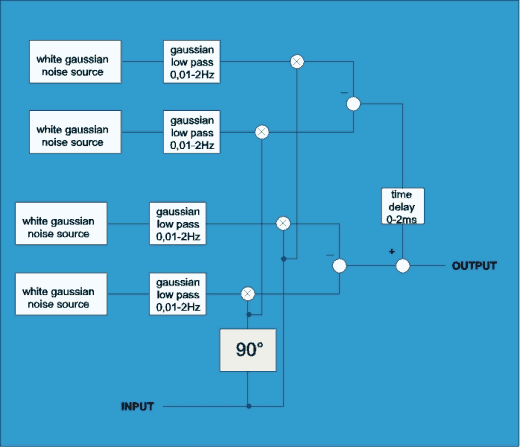
Ionospheric Simulator V1.6
using sound card and WIN95
by Michael Keller, DL6iAK
also simulates instable VFOs

This program simulates a HF link. The model is related to the so called
Watterson HF Channel Model. In this model, the ionospheric layers are assumed as a fast moving
reflecting areas. The effect of these layers on reflected HF waves can be modeled by modulating the
HF signal by a bivariate complex random process with gaussian amplitude distribution and gaussian
frequency shape. Sounds quite complicated, but the result of this complex modulation on a pure
sinoid signal spreads this signal in the frequency domain (doppler shift). The frequency spreading
(variance) can be set in the simulator depending on the quality of the simulated channel (range from
0 - excellent, no fading channel - up to 2Hz which is a really fast fading channel).

Simple two ray fading channel model
Another effect of the real HF channel are different delayed signal paths, so
several delayed versions of the transmitted signal arrive at the receiver. This can be simulated by
calculating another independent time delayed fading signal. The time delay can be set from 0 to 2
ms. The effect off this delay on narrow band signals can be ignored, but broader band signals will
show canceling of certain frequencies. For instance: a time delay of 2 ms will result in notches at
500 Hz, 1500 kHz, 2500 kHz and so on, because at these frequencies the phase difference of the two
signals will show a 180° phase shift. That's called: selective fading.
Added noise is also destroying the signal quality. This simulator assumes AWGN
(Additive White Gaussian Noise) added at a user defined level. The program measures continuously the
incoming signal level and adds the white noise at the defined SNR ratio (related to a kHz bandwidth).
In addition there is an impulsgenerator, for testing the burst behavior. Its a simple kind of markov
impulse chains. It can be started by pressing the IMP button. The impulsnoise is very soon masked if
AWGN SNR becomes low.
HF propagation is quite more complicated as it is modeled by this simple two ray
model, but a lot of effects can be shown. A HF channel is not as simple as just adding noise. When
experimenting with the program you will recognize very soon, that AWGN is a friendly enemy of
the data transmission. The real enemy is the doppler spread. Readable PSK31 data links can be done in
pure AWGN down to SNR -15 dB, but even at +20dB SNR a 0.8Hz Doppler spread will destroy a simple BPSK
(PSK31) qso. Changing to QPSK with FEC will show a dramatic increase in quality.
The program runs in my PC without problems on a 500 MHz AMD K6 II with a SB PCI 128
sound card.
An external signal at the line or micro input, will show the typical sound of a
HF channel distortion after passing the simulator. Don't miss to disable the signal source from being
passed to the output of the sound card (look at the mixer control pad of the sound card).
Download ionos.zip (328 KB)
NOTE: This program is an experimental version, any comments and advises please to:
dl6iak@gmx.de
© 2000-2001 Michael Keller

|